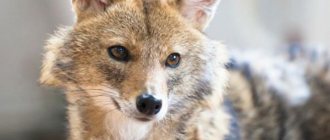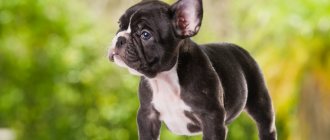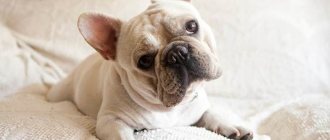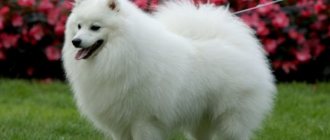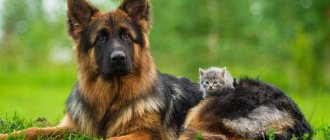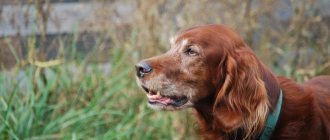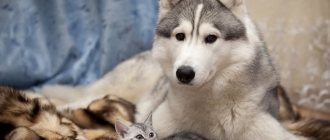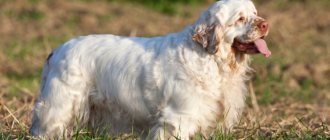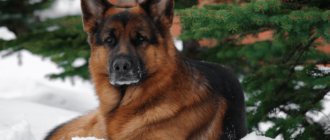| Type |
|
| Size | medium (11-25kg) |
| Main features |
|
| Included in |
|
| Intelligence | 50% |
Azawakh. Video
The Azawakh is an African greyhound dog with a refined figure and a free, independent disposition. This is one of the oldest breeds, which was bred by nomadic tribes without the participation of breeders. The appearance of Azawakh dogs causes conflicting impressions. An ignorant person, seeing a lean dog, may be horrified why he is so exhausted, literally skin and bones. And a greyhound connoisseur will admire the Azawakh’s harmonious physique and graceful movements.
The character of the African greyhound dog is also full of contradictions. For the owner and his family, he is a faithful and affectionate friend, as well as a guard and hunting assistant. And to an outsider, the dog will seem too stern and uncommunicative.
If you want to know where Azawakhs come from and why this unusual dog is so valued by exotic lovers, read on.
Dog names
By the time you purchase a puppy, it will already have a name that is included in the metric, and is also pedigree and official. Whether you use this nickname in everyday life or give it another is up to you. The following nicknames may be suitable for the African hound:
- for males - Allen, Zidler, Gurkhan, Anzhey, Gringo, Dave, Lambert and others;
- for bitches - Zakira, Veggie, Michi, Jaina, Nike, Besta and so on.
As well as other names and nicknames that will be well perceived by the dog by ear, easy to remember and pronounce.
History of the Azawakh breed
The African Azawakh breed, according to some sources, appeared about more than fifteen thousand years ago. It is believed that greyhounds descend from wolves, which were domesticated in the pre-glacial period. In their homeland, these fast dogs were very popular. However, dog breeders in Europe and America knew nothing about them for a long time.
Greyhounds have long accompanied Bedouins from the Berber and Tuareg tribes who roamed the Sahara Desert. Lean and fast dogs helped their owners in hunting and guarded property. Purebred puppies were expensive, and not everyone could have such a dog. Therefore, for Africans, the Azawakh was not just a faithful comrade and assistant, but an indicator of a person’s high status.
The lean, short-format dogs from North Africa began to be named after the Azawad Valley, where the mysterious Tuareg tribe lived. The breed has other names: Tuareg hound, South Saharan hound, Blue Berber hound.
The first purebred African greyhounds were brought from Mali to France only in the late sixties of the 20th century. In 1980, the breed was officially recognized by the International Canine Federation, and it was legalized in America in 1993.
The breed came to Russia later than to other countries, in 1986. A couple of years later, Russian Azawakhs gave birth to their first offspring. In 1998, the National Breed Club was organized.
History of the origin of the species
The Azawakh is one of the purest breeds in the world and has not been crossed between species for many centuries. The exact date of birth of the first dog is not known, but experts place it at 20-18 centuries BC . This was determined with the help of cave paintings of ancient people, who developed the breed. Cynologists claim that her ancestors were Slugi and Saluki - the most ancient dogs belonging to the group of greyhounds.
The first tribes they served are called Tuareg. That is why the Azawakhs were nicknamed Tuareg Greyhounds. The tribes were warlike and needed to protect their territories, which the Azawakhs did well. Dogs also helped in hunting.
The place of origin is easy to determine. The hottest and harshest continent is Africa . More precisely, Southern Sahara is the delta and the entire course of the Niger River. The place where the largest population of Tuareg hounds accumulated was the Azawakh Valley, which gave this breed its second name.
Despite the ban on the export and sale of dogs from Africa, these greyhounds gained popularity in Europe in the 70s of the twentieth century. This happened thanks to the French ambassador Pequer, to whom the African tribes presented an Azawakh male as a thank you for saving them from a wild elephant. Later, the same tribes gave him a female. Pecker was the first to introduce Tuareg Greyhounds to France.
There is a theory that the first Azawakh breeding country in Europe was Yugoslavia, and that the Africans did not give the dog as a gift, but allowed trade in the breed.
The Azawakh breed was officially registered in 1981, and in 1993 the FCI world standard was recognized.
At the moment, the population of Tuareg hounds in Africa is rapidly declining. There are not enough resources to raise and educate all the dogs, so nomads choose only one of the litter, usually the strongest. The remaining puppies are killed. It is believed that this way the dog will become stronger, because the mother will feed her only son, and not all of them at once. During the rainy and fertile seasons, up to three pups may be kept.
The population also suffers from attacks by wild animals and predators, which can easily cope with the Azawakhs.
Appearance of an African Greyhound dog
The figure of an Azawakh is the dream of a girl who is always on a diet and dreams of becoming a model. This is a joke, but there is a lot of truth in it.
The African greyhound dog is of “model” height, the male at the withers is from 70 cm to 74 cm. But at the same time, the Azawakh weighs like a medium-sized dog. The maximum weight of males is 25 kg.
Thin skin covered with very short hair tightly fits the dog's bones and muscles; there is no fat layer at all. The stomach is pulled up almost to the spine. However, the Azawakh does not look like an anorexic person. He is graceful and slender, and moves strongly and swiftly.
This dog has surprisingly long limbs, its figure fits into the format of an elongated rectangle.
The head of the Azavat is long and dry, the skin tightly fits the relief of the skull. The eyebrows and longitudinal furrow on the forehead are almost invisible, and the back of the head is well defined. The transition between forehead and muzzle is smoothed. The nose is dark brown or black. The jaws are strong with a scissor bite.
The Azawakh has beautiful, almond-shaped eyes, like a gazelle, and they have a brown or dark amber color. Eyelids with dark edging. The ears are wide, triangular in shape and rounded at the tip. They are thin and fit closely to the skull. If the dog is alert, he slightly raises his ears.
The neck is high, muscular, slightly arched, there is no dewlap. The back is horizontal and may rise slightly at the back. The loin is lean and short, the croup is not sloping, but sloping. The narrow chest is long, rather deep, but above the elbows. Long ribs should be clearly visible. The stomach is strongly drawn towards the lower back.
The tail is low, long and thin, whip-like with a white tassel at the end. When the dog is calm, the tail looks down, only the tip is slightly raised. If the azavat is worried, he raises his tail to the level of his back or higher.
The limbs of a dog of this breed are long and thin, standing upright. The muscles are prominent, but very dry. The feet are round and have dark pads.
The Azawakh moves especially softly and gracefully, with a spring in its gallop. This dog is distinguished by incredible ease and grace of movements.
The Azawakh is a tireless and fast runner. The dog reaches speeds of up to 65 kilometers per hour and can continue chasing for about 5 hours straight.
The body of the African greyhound is tightly covered with thin skin, the velvety hair is very short, the belly is almost naked.
Azawakhs have all shades of red in color: from sand to chestnut. The chest is decorated with small white spots. The same markings should be on all limbs. There may be tiger stripes on the body. On the head there is a black mask, sometimes a white “star”.
It has been noticed that light-colored greyhounds are stronger built, they have more muscle mass and heavier bones. Dark dogs are lighter and more graceful, but they are shorter in stature.
Any deviation from the standard is considered a defect. The most serious:
- Rough or heavy figure
- Excessively wide head
- Pronounced stop
- Excessively stretched body
- Makloki located below the withers
- Lack of pigmentation.
Height that deviates from the standard by 3 cm up or down, color not accepted in the breed, as well as anatomical anomalies will lead to the disqualification of the dog.
Other defects of the Azawakh breed:
- Eyes with overly light irises, reminiscent of the eye of a bird of prey
- Ribs that curve outward at the base of the sternum
- Coarse or long coat
- Absence of white marks on the limbs.
Outside the Azawakh breed standard there will be dogs with a fearful nature, prone to panic or aggression.
Description: short dossier
| Country of origin | Mali |
| Height | 60-74 cm |
| Weight | 15-25 kg |
| Maximum speed | 64 km/h |
| ICF classification | |
| Group | Greyhounds |
| Section | Shorthaired greyhounds |
| Number | 307 |
| FCI recognition | 1980 |
| Country of patronage of the breed | France |
| Other classifications | |
| KC Group | Hound |
| AKC Group | Miscellaneous |
| AKC Recognition | 1997 |
Character of the Azawakh breed
Azawakh dogs have a complex character that not everyone will understand and accept. Despite many years of service to people, the African greyhound has retained its wild and independent character. Therefore, the purebred Azawakh is attentive, reserved and distrustful, but not aggressive towards strangers. At the same time, the dog treats the owner and members of his family kindly and even tenderly in his own way.
In African settlements, Azawakhs serve as guards. They warn about the appearance of strangers by barking. If strangers do not pose a threat, dogs lose interest in them. They don't like to communicate with new people. Dog handlers who came to Southern Sahara to replenish the gene pool of the breed noted the unusual behavior of Azawakhs. The flock left the village when strangers appeared.
These dogs unquestioningly obey the leader of the pack and always respect the hierarchy. Therefore, the owner will have to prove his authority and show strength of character. If you were able to gain the respect of an Azawakh, he will show incredible devotion and love. However, you should not expect bright expressions of emotions from the African greyhound. A stern dog will not whine, fight in ecstasy and caress like a temperamental terrier. He always keeps his distance even in the family, but in a critical situation he protects the members of his pack.
African greyhounds treat children very evenly and reservedly. They do not like noisy games, but will tolerate the antics of younger members of the household. However, at the first opportunity they will try to hide or choose the company of adults. It is better not to take this breed into a family with small children.
Azawakhs can coexist peacefully with other pets if they are raised next to them. There may be problems with new animals. The African hound is primarily a hunter, so it is not surprising that it perceives a running cat or other animal as prey.
Azawakhs do not get along well with dogs of other breeds. They strive to dominate, and if they meet resistance, a fight may break out. But two or more greyhounds will get along well in one house. They will share roles in the pack and there will be no conflicts.
In short, Azawakhs have a strong and balanced character. They respect their owner as the leader of the pack, but they also require respectful treatment of themselves.
Features of character and behavior
There are quite a lot of differences in character between Azawakhs born and raised in Africa and those domesticated by Europeans. But they are united by devotion to the owner, activity and independence. As a rule, European dogs are more obedient, helpful and affectionate.
Africans are more capricious, but their strength is much higher. Endurance is in the genes of Tuareg hounds, but the longer they live in Europe, the worse they tolerate high temperatures.
Azawakhs are suspicious of strangers and react poorly to changes in owners. They are anxious, which characterizes them as a good guard. They make noise even when there is little danger.
Despite their stable nervous system, Azawakhs are prone to unstable behavior and aggression. African individuals rarely make contact with humans. They never attack first, but they need good and proper education.
Advantages
The Azawakh breed developed with virtually no human intervention. They are instilled with the qualities of a protector and hunter, but this does not mean that dogs do not have other advantages:
- Loyal to only one master. These greyhounds do not seek the attention of everyone they meet. They treat the owner's household and close friends well, but rarely make contact with them. People from Africa prefer solitude.
- They have a protective instinct and are good guards. This is precisely the main positive quality of the Azawakh. They are attached to their territory and will protect it. They sense danger even at a great distance and are suspicious of strangers.
- Hardy and dexterous, they are hunters who will catch up and strangle any small prey. They tolerate incredibly high temperatures and are able to live under the scorching sun.
- Smart greyhounds immediately understand their owner's commands ; whether they will carry them out is another question.
Flaws
The breeder should understand that this breed has tempered its character for many centuries. You cannot buy an Azawakh as your first pet, because he has many historical character flaws.
- First of all, Tuareg hounds are quite capricious and freedom-loving. In Africa, it is not customary to consider a dog as a pet. This animal is considered an exceptional guard that does not need to be adored and appeased.
- Azawakhs are arrogant, they will decide for themselves what they need to do and who to be friends with. Leadership qualities can interfere with a dog. Since in Africa Tuagerhounds often live in packs with a clear hierarchy, Azawakhs will fight for the place of leader to the end.
- Without proper education, they will see prey in any small animal. But even with high-quality training, they can ignore a domestic cat, but chase a yard cat.
- Very often it is impossible to determine the character of a future puppy based on standard characteristics. Each dog is so individual that it is difficult to compare it with someone from the same breed. The same applies to relationships with children. If the pet lives in a family from the very birth of the child and is accustomed to contact with others, then it will not react negatively to the baby and will even make friends with it. Otherwise, the dog may exhibit hunting instincts and mistake children for prey.
- Azawakhs value their personal space and do not like noise. Running or noisy children irritate the dog: it can chase them and knock them down.
- A significant physical disadvantage is intolerance to cold , even the slightest.
- This breed has not been fully studied , so the differences in character and habits can be dramatic. You shouldn't judge one dog by the characteristics of an entire breed.
Pros and cons of the Azawakh breed
The Azawakh breed has excellent guarding qualities. In addition, this dog is a tireless hunter. The African hound has other advantages:
- Original and elegant appearance
- Loyalty to one master
- Suspiciousness towards strangers
- Speed and agility
- Endurance and unpretentiousness
- Easy care
- Strong health
- Smartness.
Azawakhs are adapted to the harsh conditions of the desert and are accustomed to a simple life without unnecessary tenderness and emotions. Therefore, they have a special wild and freedom-loving disposition.
Hence the disadvantages of the breed:
- Show little emotion
- Submit only to the leader
- Does not get along well with dogs of other breeds
- May view small pets as prey
- Need long walks and lots of activity
- May become irritated if there is noise around them
- They are afraid of the cold.
What to look for when choosing a puppy
Almost simultaneously, the Azawakh came to Yugoslavia and France, where today the main European centers for the selection of this rare breed are located. However, the bulk of puppies are still imported from African nurseries. When choosing a puppy, it is better to give preference to trusted nurseries and breeders. The price for them will most likely be higher. But there will be no doubt about the originality of the breed.
Photo of an Azawakh puppy from Instagram account @abaelardo.pl
Azawakh puppy, photo from Instagram account @gliamicidisimo
Pedigree directly affects the cost of a dog. For example, if a puppy has a curl at the tip of its tail, it will be culled. The price for such a puppy will be significantly lower, but he will not be able to participate in exhibitions. In addition, in the Azawakh breed, puppies are selected based on their pedigree. The most valuable are representatives with African roots.
Also, a puppy that meets breed standards must have a brand, a medical card with all vaccinations and a passport.
It is better to choose a pet between the ages of 4 and 10 months. In addition to documentation, an Azawakh puppy must have distinct external characteristics that fully correspond to the description of the breed. At a young age, one can already distinguish large, strong teeth, a low-set straight tail, long legs and drooping ears.
The Azawakh was used for hundreds of years by the nomadic tribes of the African Tuareg, which left its own imprint on the character of the breed. Only an experienced dog breeder who is ready for frequent and long walks can curb the freedom-loving nature of a dog. Azawakhs of European selection are more docile, but they also remain faithful to their purpose as hunters. Therefore, keeping an Azawakh as a pet for entertainment will not work.
Raising and training an African greyhound
Before you get an Azawakh puppy, you need to think carefully about whether you are fit to be the leader of the pack and whether you have leadership qualities. This dog is not suitable for people who are insecure, restless, too emotional and unbalanced. Only a strong owner-leader can win the respect of an Azawakh, who will love the pet, but firmly demand compliance with the rules and execution of commands.
Raising a little Azawakh needs to be done as soon as he is taken into the home. Already at two months he can learn the first commands. But the educational process will continue throughout life. The dog may question the owner's decisions more than once. Therefore, the main thing in training is consistency and calm persistence.
Training should take place in a playful way, without coercion. At the same time, unnecessary tenderness is also not needed. But it is not worth using force or punishing an Azawakh. Then the teacher will not receive an obedient and submissive dog, but an embittered and stubborn one.
The owner must personally train the pet, then close contact and understanding will be established between him and the dog. If you entrust training to a canine instructor, the Azawakh may consider him the leader of the pack and will begin to ignore his owner.
Those who have personally met Azawakhs say that these dogs do not allow strangers to pet them. They literally shy away to the side. But in the show ring, well-trained greyhounds stand as still as statues.
Socialization is very important for a young Azawakh. The puppy should meet new people, be in “society”, and get impressions. You are unlikely to get much friendliness from him, but he will become more tolerant of strangers. An Azawakh dog can undergo a general training course and learn handling skills. Experts of this breed assure that African greyhounds are happy to show their stature in the exhibition ring. But the best use for this dog is hunting. In this case, the essence of the Azawakh is best revealed.
Whatever training option you choose for your pet, adhere to the main rule - no iron fists or whips. The Azawakh learns commands quickly and firmly if you entice him with gingerbread, that is, reward him with a treat.
Key points in training
There is no consensus on the Azawakhs' propensity to train. Some dog handlers believe that dogs are extremely smart and listen to their master, others believe that Azawakhs are stubborn and intractable. In any case, training a pet should begin in puppyhood, when its interest is easy to attract and its character is easy to break.
Adult Azawakhs will check the owner and examine all his commands. They are self-sufficient, so breeders need to prove their superiority and leadership.
Read about how to properly train a dog in the article: “Training a puppy: effective methods from dog handlers, learning commands at home.”
Tuareg greyhounds love active games. They enjoy running after sticks and balls, playing Frisbee, chasing, and looking for their owner.
When raising Azawakhs, you cannot show aggression: beat your pet, use brute force. This makes the dog become withdrawn and embittered. The best method is strict but fair treatment and confidence in your actions.
Keeping an Azawakh, care and feeding
The Azawakh is perfectly adapted to life in the desert; it can tolerate heat without problems and can tolerate thirst. But he will suffer from the cold and does not like rainy weather. Therefore, residents of the northern regions should not fall in love with this breed. Even if you place your dog in a warm house, he will freeze during walks, and an Azawakh needs to walk for a long time.
You can compensate for the “freezing” of the Azawakhs with warm clothing. If you wear overalls, a sweater or a jacket for a walk, your dog will feel much more comfortable. But you will have to choose a special style that will not interfere with the greyhound’s running. Please note that the dog is not a child’s size at all, its height is up to 74 cm.
In the Russian climate, the Azavat should be kept only in a heated room. It’s better in a country house with a large garden plot so that the dog can run around.
The greyhound's apartment will be cramped. She needs a lot of space. And to feel good, you need long (3-4 hours) walks without a leash.
A place for the Azawakh to sleep should be arranged near the battery; soft, warm bedding is required. Your pet will be very grateful if you give him a whole sofa.
How to care
Caring for an Azawakh is not difficult. He hardly sheds, so it’s enough to go over his skin with a brush once a week and perform hygiene measures: examine and clean his ears, eyes, teeth.
Azawakhs are bathed only when they become dirty. And they don't get dirty that often. By the way, most of these dogs cannot stand water procedures, and on the street they even avoid puddles.
How to feed
The ancestors of the Azawakhs were content with food from the owner’s table. Modern dogs are accustomed to ready-made food. To ensure your dog maintains the desired condition, choose high-quality food with a minimum of artificial additives and a maximum of nutrients.
Some dog owners practice mixed feeding: natural products plus dry food. This is convenient if the dog is often taken to exhibitions.
Adherents of natural nutrition need to carefully choose the menu for the Azawakh. It should consist of the following components:
- Carbohydrates (oatmeal, buckwheat and other grains)
- Proteins (beef, lamb, sea fish, eggs, dairy products)
- Fiber (vegetables, fruits, berries)
- Fats (vegetable oil).
Some meat products must be given raw, but not to get carried away. A protein diet can lead to excess weight. And for greyhounds, it is important to maintain a lean figure.
Possible health problems
Azawakhs are hardy, strong and healthy dogs without many of the hereditary problems that are found in other breeds that have undergone artificial selection under human direction. Occasionally, they may experience epilepsy, as well as compression of the cervical vertebrae.
Dogs of any breed are susceptible to infectious viral diseases. And Azawakhs are no exception, despite their strong immune system. To avoid serious consequences, you need to give your pet the necessary vaccinations in a timely manner, and also do not neglect regularly taking medications for worms.
Health and illness
The Azawakh is as beautiful as an Arabian horse, and as healthy and resilient as a camel. This is what they say about this breed of dog in Africa.
Indeed, these dogs, not spoiled by selection work, are distinguished by good health. Since ancient times, Azawakhs have undergone natural selection, leaving only the strongest puppies from the litter. So the heredity of dogs from Africa is remarkable. But the descendants of “European” couples are more pampered and sensitive.
The most vulnerable place is the musculoskeletal system. Azawakhs have problems with cervical vertebrae, sprains, and dislocations. Less commonly, dogs suffer from eye diseases - retinal atrophy, cataracts. Even less often - from digestive diseases.
Azawakhs have a very high pain threshold. They may get injured and not notice it. Therefore, after active walks, it is necessary to inspect and treat abrasions or other injuries.
But the most important thing is that African greyhounds have a hard time withstanding the Russian winter. They have a poor coat and no fat layer. Therefore, Azawakhs freeze quickly, they can catch a cold, and frostbite their ears and limbs.
Mating
- Tuareg greyhounds begin to breed at the age of 2 . By this period, the dog has finally grown up and is able to conceive and bear puppies. The best period for mating a female is 11-15 days of estrus.
- Before the actual act, the dogs need to be walked together. Afterwards, the female is taken to the male’s territory, where he can feel comfortable and relaxed. If the dogs cannot figure it out on their own, or they have an uncomfortable size match, the owner needs to help the process: hold the female or add pillows.
- Re-mating should be done after 2 days and after a couple of weeks .
How to choose a puppy
The Azawakh is not a very simple dog. Even if you like it, think carefully about whether you can provide the pet with proper living conditions. Do not get a greyhound if there are small children in the family, if you do not want to walk with it for a long time, if you are not ready to educate it.
If you decide to buy a puppy, get it from a reputable kennel. This is the only way you will get a real pedigree dog, without mental and health problems. But keep in mind that in Russia the Azawakh is an extremely rare breed, so there are very few breeders. You may have to look for a pet abroad. To avoid wasting time, effort and money, chat on greyhound lovers forums. There you can find contacts of foreign nurseries and read reviews about the Azawakh breed.
If you are already faced with choosing a puppy, pay attention to the most vigorous and inquisitive one. Then see if he matches the breed's exterior and is healthy. Make sure there is contact between you.
Vaccinations
Only a qualified veterinarian should vaccinate a puppy; he may refuse or reschedule the procedure. The plate contains only general criteria for vaccinations; each specialist can make his own changes.
| Vaccination schedule | |
| 2 months | Plague (distemper), parvovirus enteritis, parainfluenza, infectious hepatitis |
| 3 months | Leptospirosis, coronavirus, trichophytosis |
| 6 months | Rabies, complex vaccine |
| 12 months (every year) | Complex vaccination |
After vaccinations, puppies cannot be bathed; walks are prohibited for 12 days. Fever, weakness, and diarrhea may occur. The grafting is done in the scruff of the neck or in the thigh. The composition of the vaccinations and their names must be included in the dog’s passport. For subsequent vaccinations, you need to pay attention to the date stamps of previous vaccinations in your passport.
How much do Azawakh puppies cost?
The rarer the breed, the more expensive the dog will be. Azawakh puppies in Russia can be bought for 50-80 thousand rubles. Offspring from sires brought from Africa are especially valued.
If the price is lower, it means they are trying to deceive you or there is something wrong with the dog. An honest breeder is obliged to warn that he is offering a cull puppy. For example, the color does not meet the standard or there are other serious flaws that will not allow the dog to take part in exhibitions and breeding. If this is not important to you, you can purchase an Azawakh at a lower cost.
Price
The cost of the dog is not too budget. Therefore, you definitely won’t be able to buy an Azawakh for pennies. Officially registered breeders are ready to offer prices from $500 and above.
Azawakh puppies
However, the price may be higher. It all depends on the gender of the puppy, its pedigree, the merits of the parents and class. In nurseries, the cost may be slightly lower than from breeders. However, factors such as age and pedigree also play a role here.
Azawakh photos from our visitors
Nutrition for puppy and adult dog
For a more balanced diet for the African greyhound, it is preferable to use dry food. It should be premium from trusted manufacturers, which ideally combines essential minerals and vitamins with other nutrients.
Also, the food must meet the dog’s needs and be suitable for its age. As a delicacy, the Azawakh will enjoy a sugar bone with great pleasure. And the dog must have some water, which he can drink at any time.
Diet
The breed was bred as a companion to a person who lives in very ascetic conditions. He is always on the move. Naturally, no one would think about a special diet and care for dogs. Therefore, initially the dog ate the same as the owner. The basis of food in the desert: millet and goat's milk.
This means that the basis of the diet should be:
- cereals;
- vegetables and fruits;
- dairy products;
- a little meat or offal;
- a small amount of fish.
Of course, in modern conditions, an Azawakh can eat dry food. But it must be chosen taking into account the needs of a particular dog. The food is selected individually, preferably low-protein.
The Azawakh drinks little; his body is adapted to obtain water from food in sufficient quantity. But, as with any dog, fresh, clean water should be available at all times. Especially if you feed your dog prepared food.
Water is necessary for a dog that eats dry food. If there is not enough water, dehydration may occur.
Italian Greyhound - contents
Fans of the breed claim that it is simply impossible to find two Italian greyhounds with the same characters and preferences, but there are certain basics in their maintenance that all breeders need to take into account.
- The Mini Italian Greyhound is very curious and goes where people don’t ask 24 hours a day, so you need to constantly keep an eye on it.
- You can buy your pet a toy with which he will spend most of his time.
- He loves warmth and comfort, so he prefers to sleep with the owner, and not in a place specially designated for him.
- They can learn to go to the litter box, but “accidents” are not uncommon for this breed.
- You must walk your dog strictly on a leash, otherwise he will run away and you won’t be able to catch him, and if he gets lost, he is not always able to find his way.
- It is believed that the breed is susceptible to many diseases due to frequent inbreeding, but in recent years this trend has declined.
How to toilet train an Italian greyhound?
To toilet train a puppy, it is advisable to limit its movements around the apartment. It would be good to initially allocate some separate space for him and constantly monitor the pet. Having given him a place for these “things”: a diaper, a newspaper or a tray, show it to the puppy. It’s good if the breeder and his brothers and sisters have already started toilet training in the house.
Then all that remains is to put the used diaper in the tray so that the Italian Greyhound understands what is required of it. If not, then you should seize the moment when the puppy begins to spin and squat, and immediately carry it to the tray. Afterwards, praise and treat him to something tasty. You cannot scold your baby for puddles and piles in the wrong places, otherwise he will clean them up after himself in the only way possible - by eating, and this can cause a serious illness - coprophagia.
Who is better - a Whippet or an Italian Greyhound?
As for the first breed, it is something between a Greyhound and an Italian Greyhound. The Whippet is not inferior in activity to the breed described here, but it is more resilient, which opens up ample opportunities for spending time together. You can not only run with it, but also play agility, frisbee and the like. The Italian Greyhound is a dog, so to speak, with a more “hysterical” character. This is such a “quivering doe” that needs constant care and attention. There is an opinion about their uncleanliness and problems with the tray, but this is strictly individual.
Advantages and disadvantages
African Greyhounds are not dogs that will be a friend and companion for the whole family. Having designated one owner for themselves , they will treat him faithfully, with kindness, obedience and tenderness. The rest will be shown restraint and indifference.
These dogs are not suitable for those who have small children who will interfere with their personal space. Azawakhs do not tolerate this very well. For the same reason, they react warily to strangers, and they make good guards, zealously defending their territory.
By their nature, Azawakhs are dexterous and hardy hunters, capable of chasing prey for hours and even grabbing a bird at the moment of takeoff. They often practice these instincts on other pets with whom they find it difficult to get along.
This breed is not known for its friendliness, but anger and aggression are not inherent in them either . Independent, freedom-loving, playful and active dogs need space and freedom of movement.
Konstantin:
The breed captivated us with its working qualities and unusual appearance. I am a hunter and greyhounds are my weakness. I waited a long time for my Jackie, I even had to go abroad to the nursery myself. I believe that buying one from dubious advertisements is an unjustified and expensive risk. My dog turned out to be a wonderful hunter, or rather a huntress. The training went off with a bang, but she only perceives me, and her wife and son don’t seem to exist for her. In general, I am very pleased with the long-awaited acquisition.
Anatoly:
I always take my Azawakh with me hunting and never return home without catch. If I come across newcomers, I always catch glances in the direction of the dog full of pity. They think that it was me, such a beast, who brought the dog to exhaustion, until they see it at work and find out about the breed.

